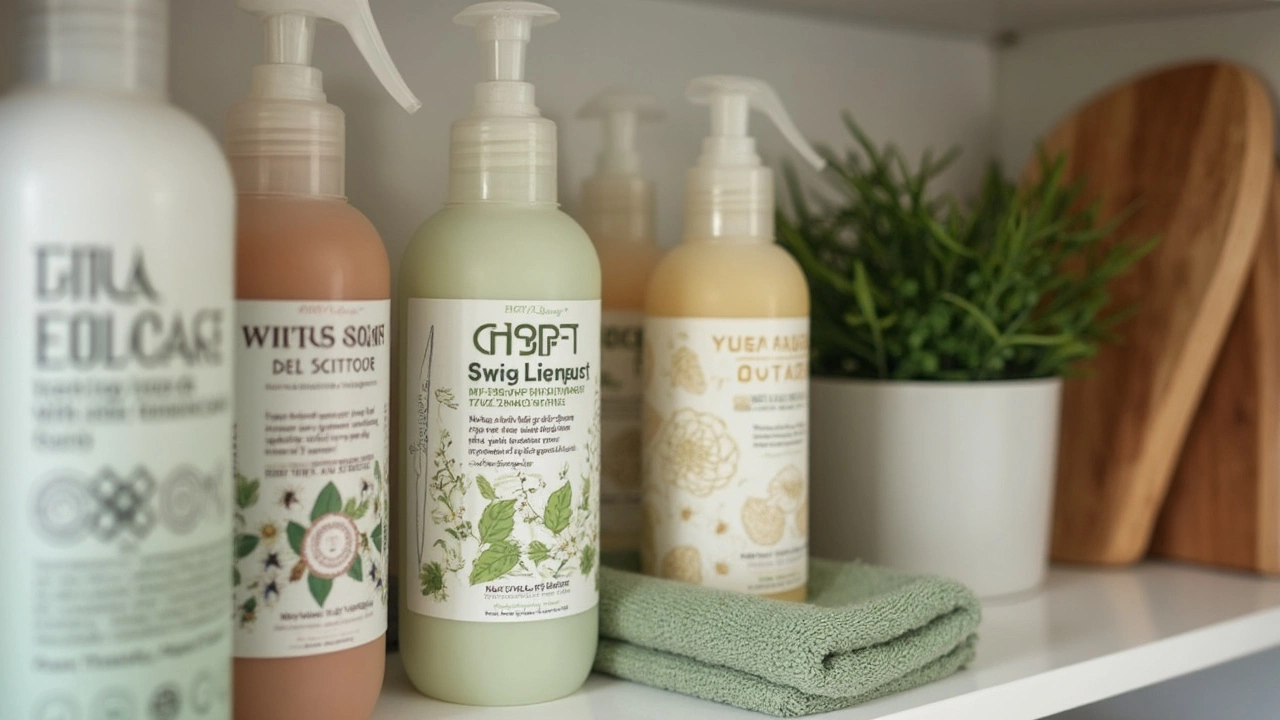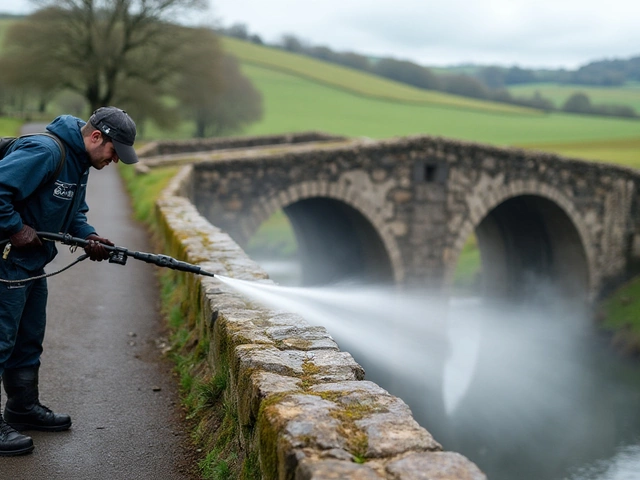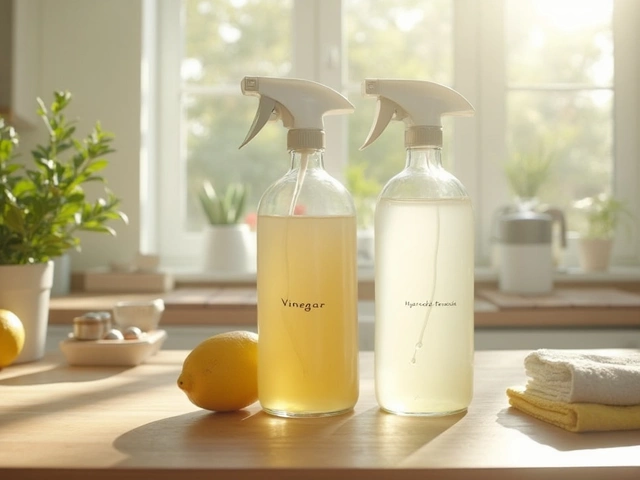If you’ve ever squinted at the tiny print on a cleaning bottle and wondered, “Is this actually eco-friendly or just good marketing?”—you’re not alone. Companies love to slap on green leaves and words like ‘natural’, but half the time, it’s more about looks than real impact. The thing is, the products you use at home do more than clean—what gets washed down your drain ends up in rivers, lakes, and sometimes, right back to you.
Some of the stuff in regular cleaners can trigger allergies, mess with asthma, and aren’t great if you share your space with a dog with a nose as sensitive as Sable’s. Real eco-friendly picks aren’t just hype; they swap out harsh chemicals for gentle, biodegradable ones that still tackle grime. Picking the right products isn’t about making some wild lifestyle change—it’s just a few smart swaps that can make your home and the planet a bit safer.
- Why Eco-Friendly Matters
- How Label Tricks Can Fool You
- Natural Ingredients to Look For
- Red Flags: Ingredients to Avoid
- Understanding Certifications and Seals
- DIY Cleaners and Smarter Shopping Tips
Why Eco-Friendly Matters
Ever notice the overpowering smell from most cleaning sprays? That’s not just a clean scent—it’s often a cocktail of chemicals, some of which can hang around in your house and mess with indoor air quality. The Environmental Protection Agency (EPA) even says indoor air can be up to five times more polluted than outside, thanks in part to commercial cleaning products.
So what’s the big deal? Regular cleaners often use ingredients like ammonia, chlorine, and phthalates. These can trigger asthma, allergies, and other breathing problems—especially for kids or pets that spend lots of time close to the ground. And Sable? Dogs use their noses for everything, so harsh chemicals hit them even harder.
Runoff from your mop water doesn’t just disappear, either. A lot of it gets washed into local rivers and streams, polluting freshwater and making life tough for fish and plants. The Natural Resources Defense Council found that about 70% of streams in the U.S. tested positive for at least one chemical from household products. That’s a wakeup call.
Eco-friendly cleaning is a really simple way to treat your home, your crew, and the planet better. Choosing products with safer ingredients shrinks your exposure to nasty stuff and puts less junk into the water table. Plus, a lot of green cleaners use packaging that’s recycled or recyclable—which cuts down on plastic trash.
| Common Chemical | Problem |
|---|---|
| Ammonia | Trigger for asthma, causes burns in large doses |
| Chlorine Bleach | Releases toxic fumes, irritating to lungs |
| Phthalates | Linked to hormone disruption |
| Phosphates | Harms aquatic life, causes algae blooms |
Switching to eco-friendly cleaning products? It’s less about being trendy and more about cutting out risks—without giving up a clean house.
How Label Tricks Can Fool You
If you trust every cleaning label out there, you’re in for a bumpy ride. Brands know everyone wants a healthy home, so they dress up bottles with words like “green,” “eco,” and “natural.” Here’s the catch: there’s very little regulation around these words in the U.S. Companies can use them even if their product isn’t remotely earth-friendly.
The real trick? It’s called "greenwashing." This is when a product looks like it’s good for the planet but still packs harsh chemicals. For example, a spray labeled “plant-based” might have only a splash of some plant extract, while the rest is just as synthetic as the next cleaner on the shelf. If a cleaner says "biodegradable," check the fine print—sometimes only one ingredient breaks down, not the whole formula.
Watch out for these tricks:
- Eco-friendly cleaning claims with no third-party seals or certifications. If it’s really certified green, it’ll have a legit stamp from EPA Safer Choice, Green Seal, or Ecologo.
- Fake natural scents or colors – most “fresh” smells come from artificial fragrances, which aren’t great for you or the environment.
- Long lists of unpronounceable ingredients hidden under blanket terms like “proprietary blend” or just “fragrance.” This lets companies hide what’s really inside.
- Smart packaging but standard contents – bottles might be recyclable or “eco” in some way, but the formula is basically old-school cleaner in disguise.
Don’t get distracted by a green cap or leaves on the label. Flip the bottle, check for actual ingredient transparency, and look for those official seals. If it’s all hype and no proof, skip it. Sable could sniff out a fake faster than you can read ‘eco’ on a sticker.
Natural Ingredients to Look For
When you're scanning for eco-friendly cleaning products, a big clue is in the ingredient list. You don’t need a chemistry degree. Just watch for a handful of safe, proven natural ingredients. These work, and you probably recognize most of them from everyday life—nothing sketchy, nothing complicated.
- Eco-friendly cleaning wins big with vinegar. It’s been used for ages to fight germs and cut through mineral buildup. Distilled white vinegar is cheap and actually knocks out bacteria and mold.
- Baking soda is another all-star. It's slightly abrasive, so it scrubs stains without scratching surfaces, and it absorbs smells like a champ. Sprinkle it in the sink or fridge, and you’ll get why people swear by it.
- Lemon juice naturally breaks up grease and leaves things smelling fresh. Plus, it kills certain strains of bacteria, so it’s good for messy kitchens or pet spots.
- Plant-based soaps, often labeled as “castile soap,” are made mostly from olive or coconut oil. They foam up well, are safe for sensitive skin, and break down fast once washed away.
- Essential oils such as tea tree, lavender, and eucalyptus aren’t just for scent. They actually have some antimicrobial properties, though be careful around pets (especially cats and little dogs), since some can be irritating when used in strong amounts.
Here’s a quick comparison of common natural cleaning ingredients and what they’re actually good at:
| Ingredient | Main Use | Bonus Fact |
|---|---|---|
| Vinegar | Disinfectant, descaler | Kills 99% of bacteria on hard surfaces |
| Baking Soda | Scrubbing, deodorizing | Breaks down protein-based stains (like eggs or blood) |
| Lemon Juice | Degreaser, freshener | Helps dissolve soap scum |
| Castile Soap | General cleaning, soft on skin | Completely biodegradable |
| Tea Tree Oil | Antimicrobial boost | Works well in diluted sprays |
Always double-check labels for these ingredients. If a product lists them first, it usually means they’re the real deal—no pretending. And if you want to mix up your own cleaner, basic mixes like vinegar with water or baking soda paste work as well (or better) than a lot of commercial brands.

Red Flags: Ingredients to Avoid
It’s easy to get overwhelmed by the ingredient lists on cleaning products, but a few red flags come up again and again. Some chemicals used in regular cleaners are not just harsh for dirt—they’re harsh for your nose, lungs, skin, and the world outside your front door. Here’s what you should watch out for if you’re aiming for a truly eco-friendly cleaning routine.
These are some of the top ingredients to avoid and why they matter:
- Phthalates – These show up in fragranced products like air fresheners and all-purpose cleaners. They’re linked with hormone disruption and can linger in your home’s air.
- Triclosan – Used as an “antibacterial” agent in soaps and cleaners. It may help bacteria build resistance and is rough on water ecosystems.
- Ammonia – While it’s strong on grime, it’s also rough on your respiratory system, especially if you’ve got kids or pets running around.
- Chlorine bleach (sodium hypochlorite) – A heavy hitter on stains, but it’s known for causing eye and skin irritation and can create harmful fumes if mixed with other chemicals.
- Synthetic Fragrances – “Fragrance” or “parfum” might cover up dozens of unknown chemicals. Some can trigger allergies or asthma.
- 2-Butoxyethanol – A solvent that helps cleaners cut through grease but can cause headaches, sore throats, and, with lots of exposure, more serious issues.
If you care about what goes down your drain, these ingredients are big warning signs. When these chemicals get washed away, they don’t just disappear—they can pollute water and hurt wildlife. Here’s a quick look at how these common chemicals stack up when it comes to health and environmental risks:
| Ingredient | Where It's Found | Potential Risks |
|---|---|---|
| Phthalates | Fragrances, air fresheners | Hormone disruption, respiratory issues |
| Triclosan | Antibacterial soaps, some dish liquids | Bacterial resistance, water contamination |
| Ammonia | Glass and bathroom cleaners | Respiratory irritation, pets at risk |
| Bleach | Laundry, toilet, and mold cleaners | Skin/eye irritation, toxic fumes |
| Synthetic Fragrances | Almost any scented product | Allergies, headaches, asthma triggers |
| 2-Butoxyethanol | Glass, window, and multipurpose cleaners | Headaches, sore throats, organ effects (with long-term exposure) |
The good news: You can skip these by checking labels for ingredient transparency, not just “green” branding. Next time you shop, pause and check those small ingredient lists, especially on anything that smells strongly or claims to kill ‘99.9% of bacteria’—that’s usually where these red flags sneak in.
Understanding Certifications and Seals
Figuring out what makes a cleaning product truly eco-friendly can feel like cracking a secret code. The best shortcut? Pay attention to third-party certifications on the label. These badges aren’t just decoration—they actually mean someone checked that the product meets real environmental standards.
Here are a few common certifications to look for when picking eco-friendly cleaning products:
- Green Seal: This one’s tough to get. Products have to pass tests that look at how well they work, how safe the ingredients are, and how good they are for the planet from start to finish. A Green Seal logo means the cleaner has low toxicity, no cancer-causing stuff, and breaks down safely in water.
- EPA Safer Choice: This blue-and-green label from the U.S. Environmental Protection Agency means every ingredient in the bottle has been reviewed for human and environmental safety. They even check if it’s safe for pets and kids.
- EcoLogo/UL Ecologo: Based in Canada but found elsewhere, this certification says the product meets strict rules for reduced environmental impact and health risks. They look at everything from air quality in your home to how the packaging is made.
- Cradle to Cradle: This badge means the product is designed with an eye on reusing resources and making less waste. They check the full life cycle, from how ingredients are sourced to how you toss the bottle when it’s empty.
If you don’t see these marks, be a little skeptical. Words like “green,” “natural,” or “plant-based” aren’t regulated. So, products can use them even if they’re not much different from regular old cleaners.
| Certification | What It Means | Why It Matters |
|---|---|---|
| Green Seal | Meets strict standards for performance, health, and safety | Limits harmful chemicals, proven effectiveness |
| EPA Safer Choice | Reviews every ingredient for safety | Reduces risks for you, pets, and nature |
| EcoLogo | Full review of lifecycle and toxicity | Less indoor air pollution, better packaging |
| Cradle to Cradle | Focuses on reuse and sustainable design | Encourages recycling, less waste |
Bottom line: when searching for eco-friendly cleaning options, certifications are your best friend. They help you skip the greenwashing and get straight to the real deal. Just spot one of these seals and you can feel way more confident about what you’re bringing home.
DIY Cleaners and Smarter Shopping Tips
Sometimes, the greenest cleaning product is the one you whip up in your own kitchen. Basic stuff like white vinegar, baking soda, lemon juice, and castile soap are all-stars that tackle a ton of household messes—cheap, effective, and no chemical headaches. These workhorses actually break down grime and germs, instead of just spreading them around or masking smells.
If you’re new to DIY solutions, here are a few recipes to cover most jobs at home:
- All-purpose spray: Mix 1 cup white vinegar, 1 cup water, and a few drops of your favorite essential oil. Perfect for counters and glass.
- Scrubbing paste: Blend 3 parts baking soda and 1 part water to form a paste. This cuts through soap scum and stuck-on food like a pro.
- Floor cleaner: Mix 1/4 cup castile soap with 2 gallons warm water. No sticky residue, no harsh fumes—safe even if your dog licks the floor.
Worried about effectiveness? Researchers from the University of North Carolina found simple vinegar and baking soda solutions removed up to 98% of bacteria on hard surfaces in home tests. You don’t need a big brand name to get things genuinely clean.
If mixing your own isn’t your thing, look for eco-friendly cleaning products with clear ingredient lists, recognized certifications (like EPA Safer Choice or Green Seal), and minimal plastic packaging. Always check that “plant-based” isn’t just a headline—scan for specifics and watch out for vague terms like “fragrance” or “proprietary blend.”
Here’s a quick table comparing basic costs and plastic use between DIY and store-bought options to help put things in perspective:
| Product | Average Cost (Per 16oz) | Typical Packaging |
|---|---|---|
| DIY Vinegar Cleaner | $0.40 | Reusable spray bottle |
| Store-bought Green Cleaner | $4.00 | Single-use plastic |
| Regular Brand Cleaner | $3.00 | Single-use plastic |
Small changes—like making your own sprays or picking brands that let you refill bottles—can seriously cut your plastic waste and save you money over time. And honestly, it’s comforting to know exactly what you’re spraying around in your kitchen or near your pets (especially if you’ve got a curious dog like Sable sniffing every corner).




